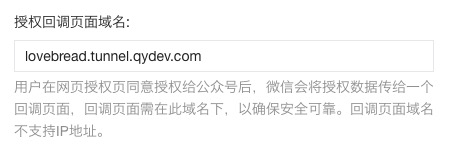[微信開發] 微信網頁授權Java實現
1、需要有一個公眾號,拿到AppID和AppSecret;
2、進入公眾號開發者中心頁配置授權回撥域名。具體位置:介面許可權-網頁服務-網頁賬號-網頁授權獲取使用者基本資訊-修改
注意,這裡僅需填寫全域名(如www.qq.com、www.baidu.com),勿加 http:// 等協議頭及具體的地址欄位;
這個域名需要是一個備案過的域名。這個條件比較難辦,幸好熱心的網友qydev為我們無私地提供了一個備案過的域名,我們可以通過使用Ngrok來虛擬一個域名對映到本地開發環境,簡直是web開發神器啊。。
qydev版Ngrok使用說明及下載地址:http://www.qydev.com/
本文以 lovebread.tunnel.qydev.com 域名為例:

3、如果嫌手機上測試麻煩,可以使用微信官方提供的web開發者工具直接在瀏覽器中進行除錯。
前提是需要在微信公眾號中繫結開發者賬號:登入公眾號-開發者工具-進入web開發者工具-繫結web開發者微信賬號
使用說明及下載地址:https://mp.weixin.qq.com/wiki?action=doc&id=mp1455784140&t=0.7272727088156665&token=&lang=zh_CN#6
授權步驟:
1、引導使用者進入授權頁面同意授權,獲取code
2、通過code換取網頁授權access_token(與基礎支援中的access_token不同)
3、通過網頁授權access_token和openid獲取使用者基本資訊

Java實現:
1、引導使用者進入授權頁面同意授權,獲取code
這一步其實就是將需要授權的頁面url拼接到微信的認證請求介面裡面,比如需要使用者在訪問頁面 lovebread.tunnel.qydev.com/auth 時進行授權認證,那麼拼接後的授權驗證地址為:
https://open.weixin.qq.com/connect/oauth2/authorize?appid=wx88888888&redirect_uri=http://lovebread.tunnel.qydev.com/auth&response_type=code&scope=snsapi_base&state=xxxx_state#wechat_redirect
這裡面需要替換appid、redirect_uri為實際的資訊。其中的scope引數有兩個值:
snsapi_base:只能獲取到使用者openid。好處是靜預設證,無需使用者手動點選認證按鈕,感覺上像是直接進入網站一樣。
snsapi_userinfo:可以獲取到openid、暱稱、頭像、所在地等資訊。需要使用者手動點選認證按鈕。
相關程式碼:
/** * 生成用於獲取access_token的Code的Url * * @param redirectUrl * @return */ public String getRequestCodeUrl(String redirectUrl) { return String.format("https://open.weixin.qq.com/connect/oauth2/authorize?appid=%s&redirect_uri=%s&response_type=code&scope=%s&state=%s#wechat_redirect", APPID, redirectUrl, "snsapi_userinfo", "xxxx_state"); }
2、通過第一步獲取的code換取網頁授權access_token(與基礎支援中的access_token不同)
這一步需要在控制器中獲取微信回傳給我們的code,通過這個code來請求access_token。
/** * 路由控制 * * @param request * @param code * @return */ @GET @Path("auth") public Response auth(@Context HttpServletRequest request, @QueryParam("code") String code) { Map<String, String> data = new HashMap(); Map<String, String> result = wechatUtils.getUserInfoAccessToken(code);//通過這個code獲取access_token String openId = result.get("openid"); if (StringUtils.isNotEmpty(openId)) { logger.info("try getting user info. [openid={}]", openId); Map<String, String> userInfo = wechatUtils.getUserInfo(result.get("access_token"), openId);//使用access_token獲取使用者資訊 logger.info("received user info. [result={}]", userInfo); return forward("auth", userInfo); } return Response.ok("openid為空").build(); }
/** * 獲取請求使用者資訊的access_token * * @param code * @return */ public Map<String, String> getUserInfoAccessToken(String code) { JsonObject object = null; Map<String, String> data = new HashMap(); try { String url = String.format("https://api.weixin.qq.com/sns/oauth2/access_token?appid=%s&secret=%s&code=%s&grant_type=authorization_code", APPID, APPSECRET, code); logger.info("request accessToken from url: {}", url); DefaultHttpClient httpClient = new DefaultHttpClient(); HttpGet httpGet = new HttpGet(url); HttpResponse httpResponse = httpClient.execute(httpGet); HttpEntity httpEntity = httpResponse.getEntity(); String tokens = EntityUtils.toString(httpEntity, "utf-8"); Gson token_gson = new Gson(); object = token_gson.fromJson(tokens, JsonObject.class); logger.info("request accessToken success. [result={}]", object); data.put("openid", object.get("openid").toString().replaceAll("\"", "")); data.put("access_token", object.get("access_token").toString().replaceAll("\"", "")); } catch (Exception ex) { logger.error("fail to request wechat access token. [error={}]", ex); } return data; }
請求access_token返回樣例:
[result={
"access_token":"OezXcEiiBSKSxW0eoylIeK6mXnzDdGmembMkERL1o1PtpJBEFDaCSwseSTzvZhiKK7Q35O-YctaOFfyJYSPMMEsMq62zw8T6VDljgKJY6g-tCMdTr3Yoeaz1noL6gpJeshMPwEXL5Pj3YBkw",
"expires_in":7200,
"refresh_token":"OezXcEiiBSKSxW0eoylIeK6mXnzDdGmembMkERL1o1PtpJBEFDaCSwseSTOIGqz3ySJRe-lv124wxxtrBdXGd3X1YGysFJnCxjtIE-jaMkvT7aN-12nBa4YtDvr5VSKCU-_UeFFnfW0K3JmZGRA",
"openid":"oN9UryuC0Y01aQt0jKxZXbfe658w",
"scope":"snsapi_userinfo"}]
通過access_token和openid獲取使用者基本資訊:
/** * 獲取使用者資訊 * * @param accessToken * @param openId * @return */ public Map<String, String> getUserInfo(String accessToken, String openId) { Map<String, String> data = new HashMap(); String url = "https://api.weixin.qq.com/sns/userinfo?access_token=" + accessToken + "&openid=" + openId + "&lang=zh_CN"; logger.info("request user info from url: {}", url); JsonObject userInfo = null; try { DefaultHttpClient httpClient = new DefaultHttpClient(); HttpGet httpGet = new HttpGet(url); HttpResponse httpResponse = httpClient.execute(httpGet); HttpEntity httpEntity = httpResponse.getEntity(); String response = EntityUtils.toString(httpEntity, "utf-8"); Gson token_gson = new Gson(); userInfo = token_gson.fromJson(response, JsonObject.class); logger.info("get userinfo success. [result={}]", userInfo); data.put("openid", userInfo.get("openid").toString().replaceAll("\"", "")); data.put("nickname", userInfo.get("nickname").toString().replaceAll("\"", "")); data.put("city", userInfo.get("city").toString().replaceAll("\"", "")); data.put("province", userInfo.get("province").toString().replaceAll("\"", "")); data.put("country", userInfo.get("country").toString().replaceAll("\"", "")); data.put("headimgurl", userInfo.get("headimgurl").toString().replaceAll("\"", "")); } catch (Exception ex) { logger.error("fail to request wechat user info. [error={}]", ex); } return data; }
獲取使用者資訊返回樣例:
[result={
"openid":"oN9UryuC0Y01aQt0jKxZXbfe658w",
"nickname":"lovebread",
"sex":1,
"language":"zh_CN",
"city":"",
"province":"",
"country":"中國",
"headimgurl":"http://wx.qlogo.cn/mmopen/bRLXzTf2f6HNfBTd72heAA7vNKsGKvK3dfreewrewsPff9OaMWib0GibbA8daQmNQvQhagtiaicf4vNC5nYU3ia821QQ/0",
"privilege":[]}]
相關文章
- 微信開發-微信網頁開發-授權多次回撥網頁
- 微信網頁授權網頁
- 微信公眾號開發 —— 微信網頁授權小記網頁
- ajax 實現微信網頁授權登入網頁
- Spring Security中實現微信網頁授權Spring網頁
- 微信公眾號開發Django 網頁授權Django網頁
- 微信網頁靜默授權網頁
- Laravel 微信 Token 配置 與微信網頁授權操作Laravel網頁
- 小程式登入、微信網頁授權(Java版)網頁Java
- 微信網頁授權視訊教程網頁
- 微信開發筆記——微信網頁登入授權,獲取使用者資訊筆記網頁
- 第三方微信登入 | 靜默授權與網頁授權的實現網頁
- .NET微信網頁開發之網頁授權獲取使用者基本資訊網頁
- 微信網頁授權登入(c# Webform)網頁C#WebORM
- 微信授權註冊或微信登陸 微信授權登陸 基於若依vue 實現Vue
- .NET Core企業微信網頁授權登入網頁
- C#微信網頁授權登入(NET MVC)C#網頁MVC
- java 微信授權登入配置Java
- 微信小程式開發之webview元件內網頁實現微信原生支付微信小程式WebView元件內網網頁
- 前端微信授權前端
- 微信分享、網頁授權、客服傳送資訊外掛網頁
- 微信網頁授權並獲取使用者資訊網頁
- 微信公眾號開發Django JSSDK授權DjangoJS
- 微信小程式——授權微信小程式
- 微信授權(Net Mvc)MVC
- 微信授權管理功能
- 微信裡的”授權“
- 微信授權登入
- Java微信授權登入小程式介面Java
- iOS開發之微信聊天頁面實現iOS
- 原生微信網頁授權登入(藉助natapp穿牆)網頁APP
- 微信公眾號網頁授權中轉功能-解決網頁授權域名個數限制-透過已授權的域名進行中轉網頁
- 記微信網頁開發單頁面返回不重新整理的實現網頁
- 前端實現微信公眾號授權—獲取openid前端
- 使用微信wx-open-launch-app標籤實現微信網頁開啟AppAPP網頁
- 微信小程式授權登入最佳實踐微信小程式
- 微信網頁授權之access_token和refreshtoken區別與聯絡網頁
- vue 微信授權解決方案Vue
